Advanced Management Accounting Analysis: Fletcher Building Limited
VerifiedAdded on 2023/06/04
|13
|3073
|305
Report
AI Summary
This report presents an in-depth analysis of advanced management accounting, specifically focusing on its application to Fletcher Building Limited. The report begins by exploring fundamental concepts such as vision, mission, and strategy, providing insights into how Fletcher Building Limited defines its objectives. It then delves into strategic cost management, examining the company's current costing methods and advocating for the adoption of activity-based costing and a just-in-time (JIT) system to enhance cost information reliability and efficiency. The report also evaluates the company's performance measures, assessing their effectiveness and suggesting improvements, particularly in tracking sales growth. Furthermore, the report explores the use of a balanced scorecard to align strategic objectives with performance measures and concludes with a discussion on competitor accounting and analysis, emphasizing the importance of understanding competitors' strengths and weaknesses for strategic decision-making. This comprehensive analysis offers valuable insights into the financial and strategic management practices of Fletcher Building Limited.
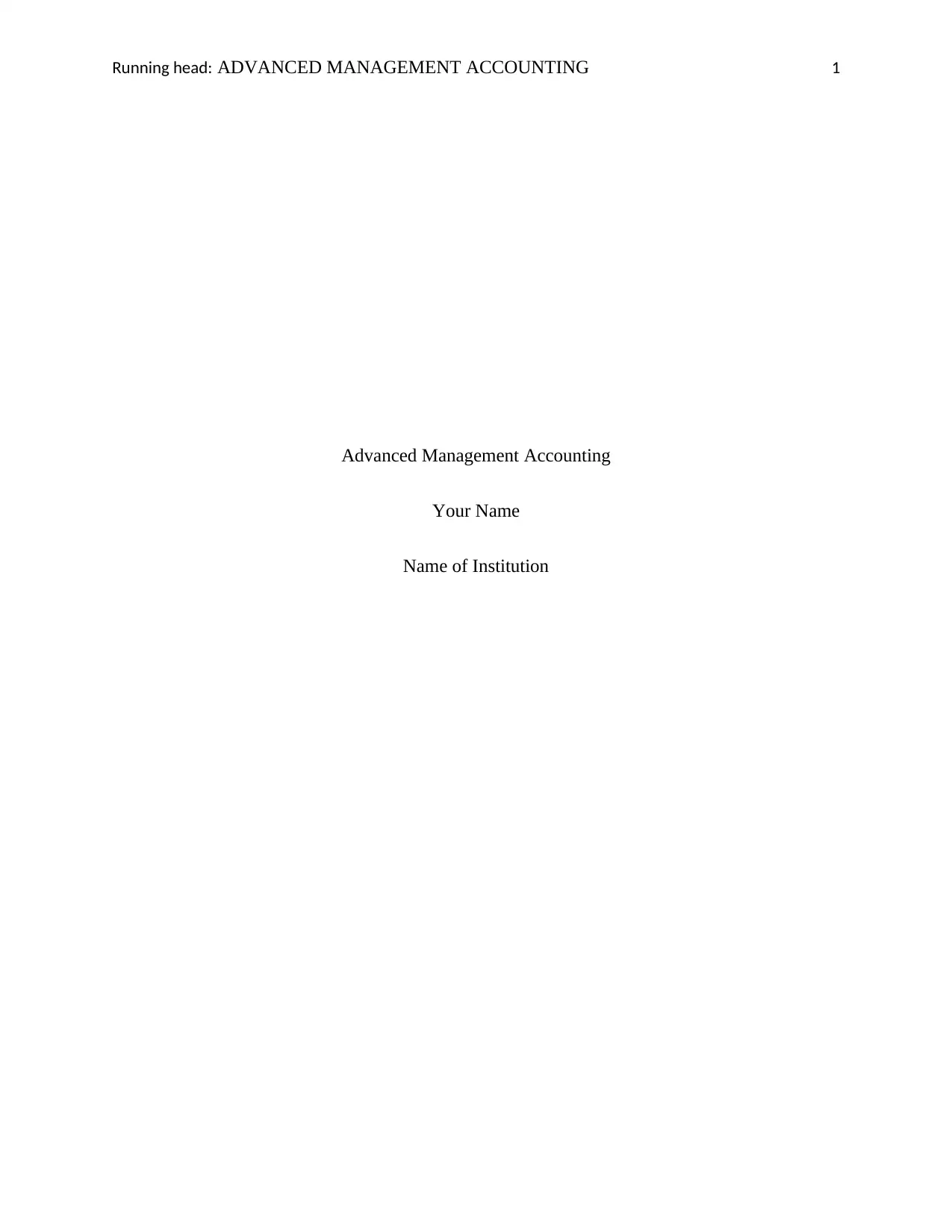
Running head: ADVANCED MANAGEMENT ACCOUNTING 1
Advanced Management Accounting
Your Name
Name of Institution
Advanced Management Accounting
Your Name
Name of Institution
Paraphrase This Document
Need a fresh take? Get an instant paraphrase of this document with our AI Paraphraser
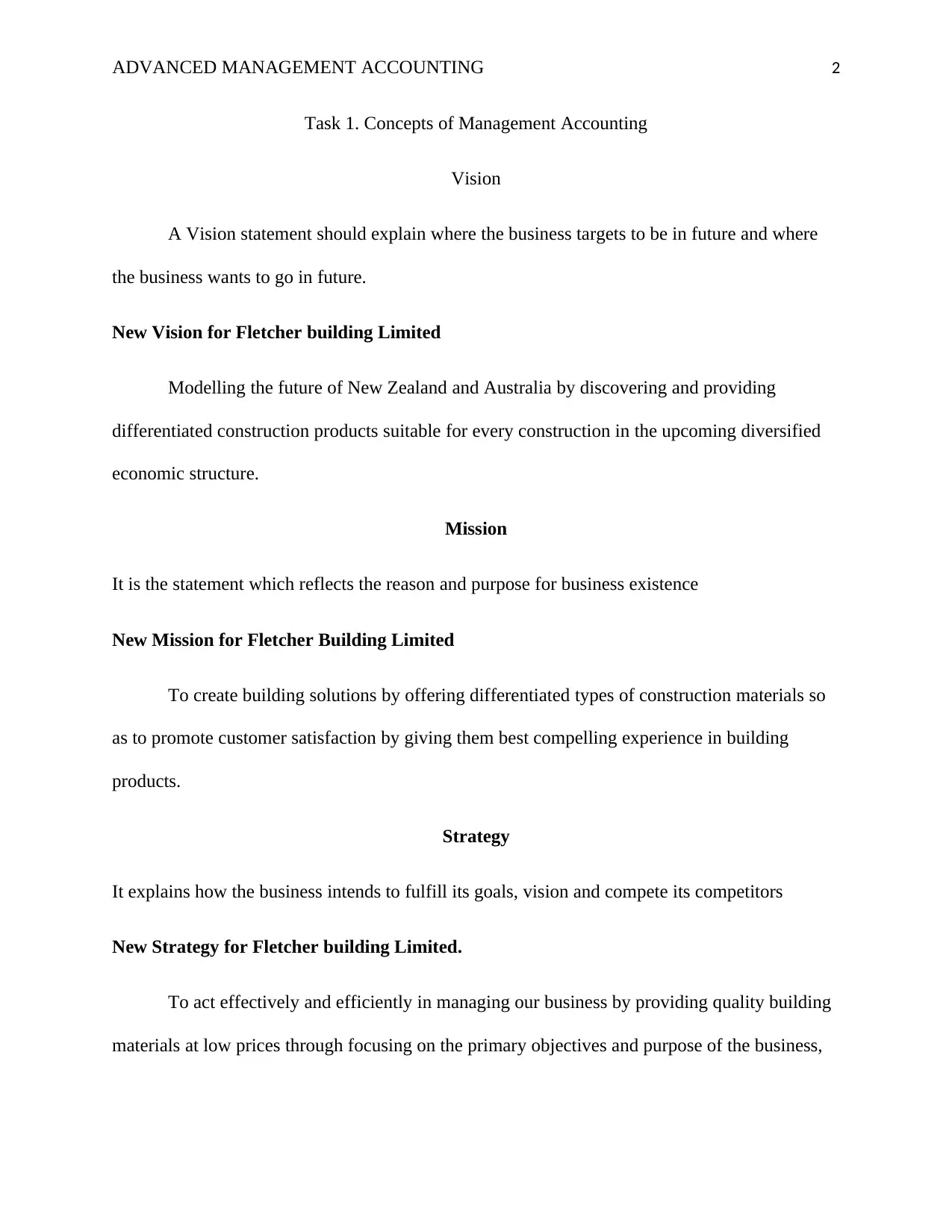
ADVANCED MANAGEMENT ACCOUNTING 2
Task 1. Concepts of Management Accounting
Vision
A Vision statement should explain where the business targets to be in future and where
the business wants to go in future.
New Vision for Fletcher building Limited
Modelling the future of New Zealand and Australia by discovering and providing
differentiated construction products suitable for every construction in the upcoming diversified
economic structure.
Mission
It is the statement which reflects the reason and purpose for business existence
New Mission for Fletcher Building Limited
To create building solutions by offering differentiated types of construction materials so
as to promote customer satisfaction by giving them best compelling experience in building
products.
Strategy
It explains how the business intends to fulfill its goals, vision and compete its competitors
New Strategy for Fletcher building Limited.
To act effectively and efficiently in managing our business by providing quality building
materials at low prices through focusing on the primary objectives and purpose of the business,
Task 1. Concepts of Management Accounting
Vision
A Vision statement should explain where the business targets to be in future and where
the business wants to go in future.
New Vision for Fletcher building Limited
Modelling the future of New Zealand and Australia by discovering and providing
differentiated construction products suitable for every construction in the upcoming diversified
economic structure.
Mission
It is the statement which reflects the reason and purpose for business existence
New Mission for Fletcher Building Limited
To create building solutions by offering differentiated types of construction materials so
as to promote customer satisfaction by giving them best compelling experience in building
products.
Strategy
It explains how the business intends to fulfill its goals, vision and compete its competitors
New Strategy for Fletcher building Limited.
To act effectively and efficiently in managing our business by providing quality building
materials at low prices through focusing on the primary objectives and purpose of the business,
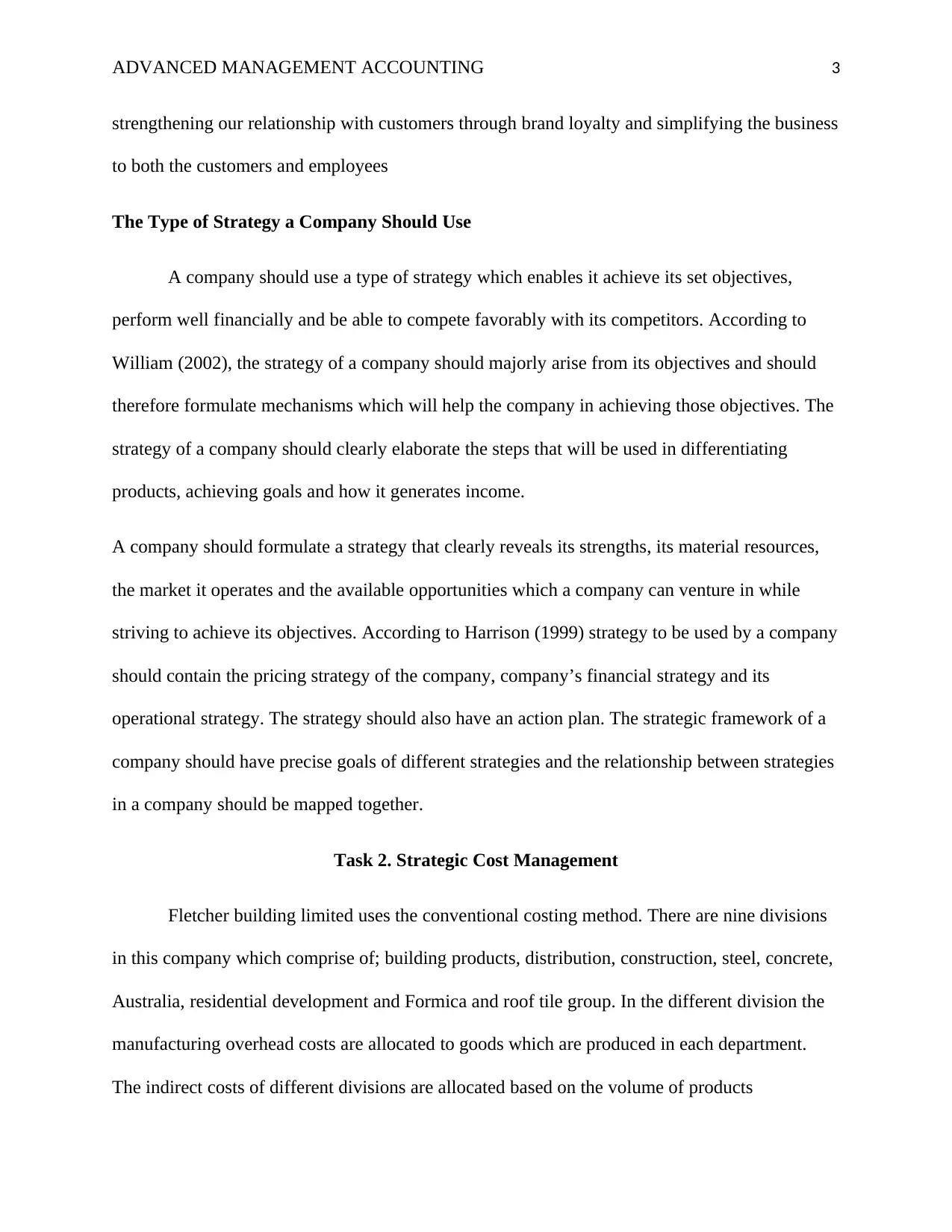
ADVANCED MANAGEMENT ACCOUNTING 3
strengthening our relationship with customers through brand loyalty and simplifying the business
to both the customers and employees
The Type of Strategy a Company Should Use
A company should use a type of strategy which enables it achieve its set objectives,
perform well financially and be able to compete favorably with its competitors. According to
William (2002), the strategy of a company should majorly arise from its objectives and should
therefore formulate mechanisms which will help the company in achieving those objectives. The
strategy of a company should clearly elaborate the steps that will be used in differentiating
products, achieving goals and how it generates income.
A company should formulate a strategy that clearly reveals its strengths, its material resources,
the market it operates and the available opportunities which a company can venture in while
striving to achieve its objectives. According to Harrison (1999) strategy to be used by a company
should contain the pricing strategy of the company, company’s financial strategy and its
operational strategy. The strategy should also have an action plan. The strategic framework of a
company should have precise goals of different strategies and the relationship between strategies
in a company should be mapped together.
Task 2. Strategic Cost Management
Fletcher building limited uses the conventional costing method. There are nine divisions
in this company which comprise of; building products, distribution, construction, steel, concrete,
Australia, residential development and Formica and roof tile group. In the different division the
manufacturing overhead costs are allocated to goods which are produced in each department.
The indirect costs of different divisions are allocated based on the volume of products
strengthening our relationship with customers through brand loyalty and simplifying the business
to both the customers and employees
The Type of Strategy a Company Should Use
A company should use a type of strategy which enables it achieve its set objectives,
perform well financially and be able to compete favorably with its competitors. According to
William (2002), the strategy of a company should majorly arise from its objectives and should
therefore formulate mechanisms which will help the company in achieving those objectives. The
strategy of a company should clearly elaborate the steps that will be used in differentiating
products, achieving goals and how it generates income.
A company should formulate a strategy that clearly reveals its strengths, its material resources,
the market it operates and the available opportunities which a company can venture in while
striving to achieve its objectives. According to Harrison (1999) strategy to be used by a company
should contain the pricing strategy of the company, company’s financial strategy and its
operational strategy. The strategy should also have an action plan. The strategic framework of a
company should have precise goals of different strategies and the relationship between strategies
in a company should be mapped together.
Task 2. Strategic Cost Management
Fletcher building limited uses the conventional costing method. There are nine divisions
in this company which comprise of; building products, distribution, construction, steel, concrete,
Australia, residential development and Formica and roof tile group. In the different division the
manufacturing overhead costs are allocated to goods which are produced in each department.
The indirect costs of different divisions are allocated based on the volume of products
⊘ This is a preview!⊘
Do you want full access?
Subscribe today to unlock all pages.

Trusted by 1+ million students worldwide
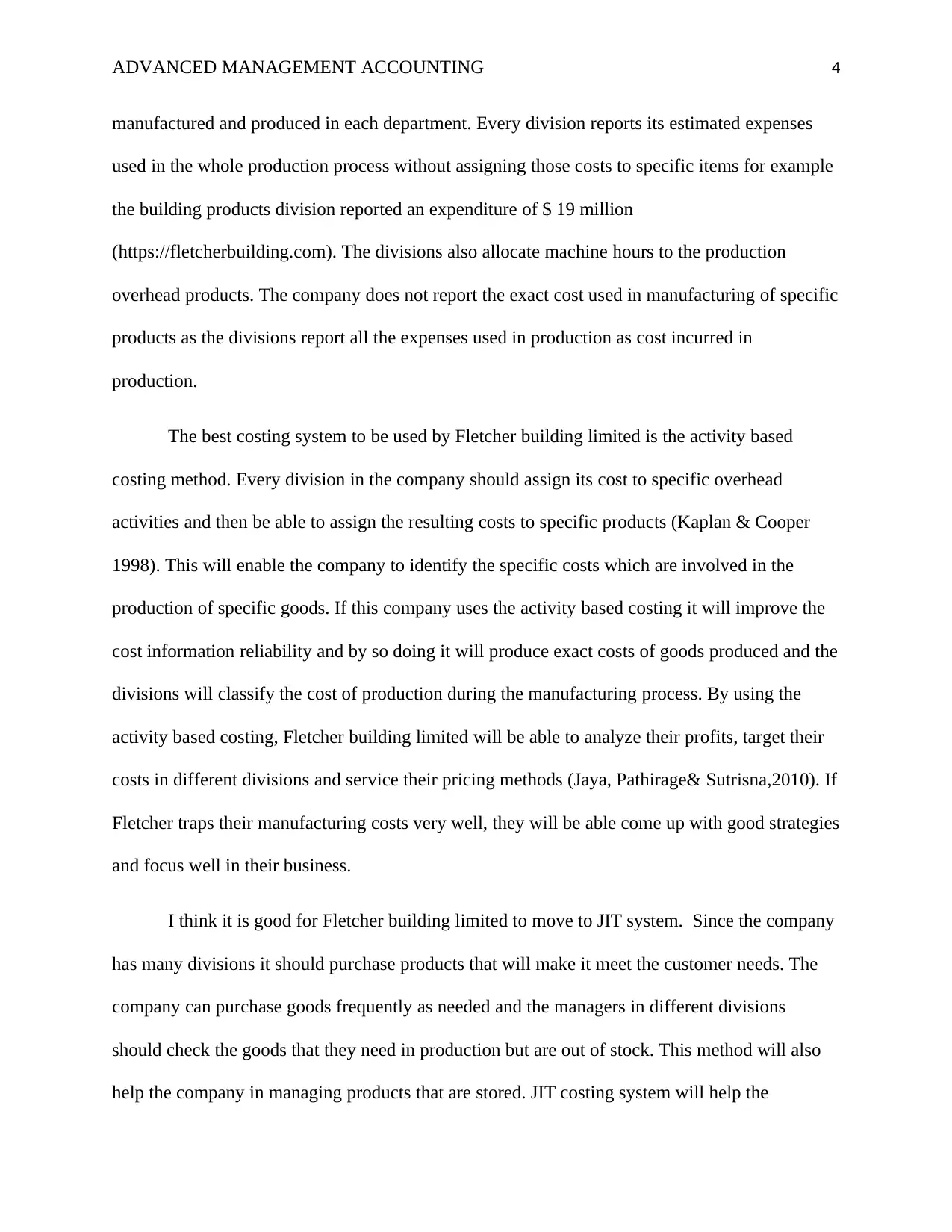
ADVANCED MANAGEMENT ACCOUNTING 4
manufactured and produced in each department. Every division reports its estimated expenses
used in the whole production process without assigning those costs to specific items for example
the building products division reported an expenditure of $ 19 million
(https://fletcherbuilding.com). The divisions also allocate machine hours to the production
overhead products. The company does not report the exact cost used in manufacturing of specific
products as the divisions report all the expenses used in production as cost incurred in
production.
The best costing system to be used by Fletcher building limited is the activity based
costing method. Every division in the company should assign its cost to specific overhead
activities and then be able to assign the resulting costs to specific products (Kaplan & Cooper
1998). This will enable the company to identify the specific costs which are involved in the
production of specific goods. If this company uses the activity based costing it will improve the
cost information reliability and by so doing it will produce exact costs of goods produced and the
divisions will classify the cost of production during the manufacturing process. By using the
activity based costing, Fletcher building limited will be able to analyze their profits, target their
costs in different divisions and service their pricing methods (Jaya, Pathirage& Sutrisna,2010). If
Fletcher traps their manufacturing costs very well, they will be able come up with good strategies
and focus well in their business.
I think it is good for Fletcher building limited to move to JIT system. Since the company
has many divisions it should purchase products that will make it meet the customer needs. The
company can purchase goods frequently as needed and the managers in different divisions
should check the goods that they need in production but are out of stock. This method will also
help the company in managing products that are stored. JIT costing system will help the
manufactured and produced in each department. Every division reports its estimated expenses
used in the whole production process without assigning those costs to specific items for example
the building products division reported an expenditure of $ 19 million
(https://fletcherbuilding.com). The divisions also allocate machine hours to the production
overhead products. The company does not report the exact cost used in manufacturing of specific
products as the divisions report all the expenses used in production as cost incurred in
production.
The best costing system to be used by Fletcher building limited is the activity based
costing method. Every division in the company should assign its cost to specific overhead
activities and then be able to assign the resulting costs to specific products (Kaplan & Cooper
1998). This will enable the company to identify the specific costs which are involved in the
production of specific goods. If this company uses the activity based costing it will improve the
cost information reliability and by so doing it will produce exact costs of goods produced and the
divisions will classify the cost of production during the manufacturing process. By using the
activity based costing, Fletcher building limited will be able to analyze their profits, target their
costs in different divisions and service their pricing methods (Jaya, Pathirage& Sutrisna,2010). If
Fletcher traps their manufacturing costs very well, they will be able come up with good strategies
and focus well in their business.
I think it is good for Fletcher building limited to move to JIT system. Since the company
has many divisions it should purchase products that will make it meet the customer needs. The
company can purchase goods frequently as needed and the managers in different divisions
should check the goods that they need in production but are out of stock. This method will also
help the company in managing products that are stored. JIT costing system will help the
Paraphrase This Document
Need a fresh take? Get an instant paraphrase of this document with our AI Paraphraser
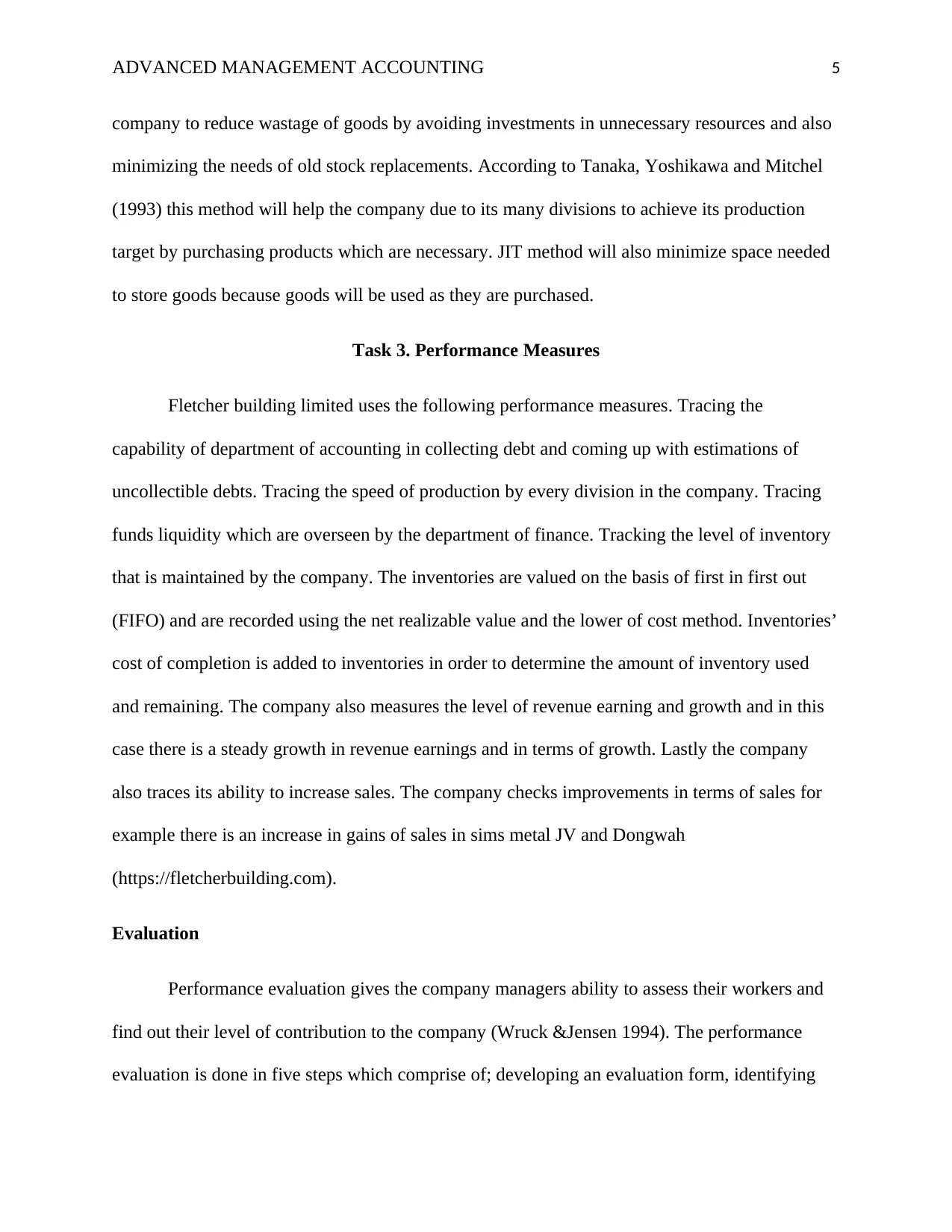
ADVANCED MANAGEMENT ACCOUNTING 5
company to reduce wastage of goods by avoiding investments in unnecessary resources and also
minimizing the needs of old stock replacements. According to Tanaka, Yoshikawa and Mitchel
(1993) this method will help the company due to its many divisions to achieve its production
target by purchasing products which are necessary. JIT method will also minimize space needed
to store goods because goods will be used as they are purchased.
Task 3. Performance Measures
Fletcher building limited uses the following performance measures. Tracing the
capability of department of accounting in collecting debt and coming up with estimations of
uncollectible debts. Tracing the speed of production by every division in the company. Tracing
funds liquidity which are overseen by the department of finance. Tracking the level of inventory
that is maintained by the company. The inventories are valued on the basis of first in first out
(FIFO) and are recorded using the net realizable value and the lower of cost method. Inventories’
cost of completion is added to inventories in order to determine the amount of inventory used
and remaining. The company also measures the level of revenue earning and growth and in this
case there is a steady growth in revenue earnings and in terms of growth. Lastly the company
also traces its ability to increase sales. The company checks improvements in terms of sales for
example there is an increase in gains of sales in sims metal JV and Dongwah
(https://fletcherbuilding.com).
Evaluation
Performance evaluation gives the company managers ability to assess their workers and
find out their level of contribution to the company (Wruck &Jensen 1994). The performance
evaluation is done in five steps which comprise of; developing an evaluation form, identifying
company to reduce wastage of goods by avoiding investments in unnecessary resources and also
minimizing the needs of old stock replacements. According to Tanaka, Yoshikawa and Mitchel
(1993) this method will help the company due to its many divisions to achieve its production
target by purchasing products which are necessary. JIT method will also minimize space needed
to store goods because goods will be used as they are purchased.
Task 3. Performance Measures
Fletcher building limited uses the following performance measures. Tracing the
capability of department of accounting in collecting debt and coming up with estimations of
uncollectible debts. Tracing the speed of production by every division in the company. Tracing
funds liquidity which are overseen by the department of finance. Tracking the level of inventory
that is maintained by the company. The inventories are valued on the basis of first in first out
(FIFO) and are recorded using the net realizable value and the lower of cost method. Inventories’
cost of completion is added to inventories in order to determine the amount of inventory used
and remaining. The company also measures the level of revenue earning and growth and in this
case there is a steady growth in revenue earnings and in terms of growth. Lastly the company
also traces its ability to increase sales. The company checks improvements in terms of sales for
example there is an increase in gains of sales in sims metal JV and Dongwah
(https://fletcherbuilding.com).
Evaluation
Performance evaluation gives the company managers ability to assess their workers and
find out their level of contribution to the company (Wruck &Jensen 1994). The performance
evaluation is done in five steps which comprise of; developing an evaluation form, identifying
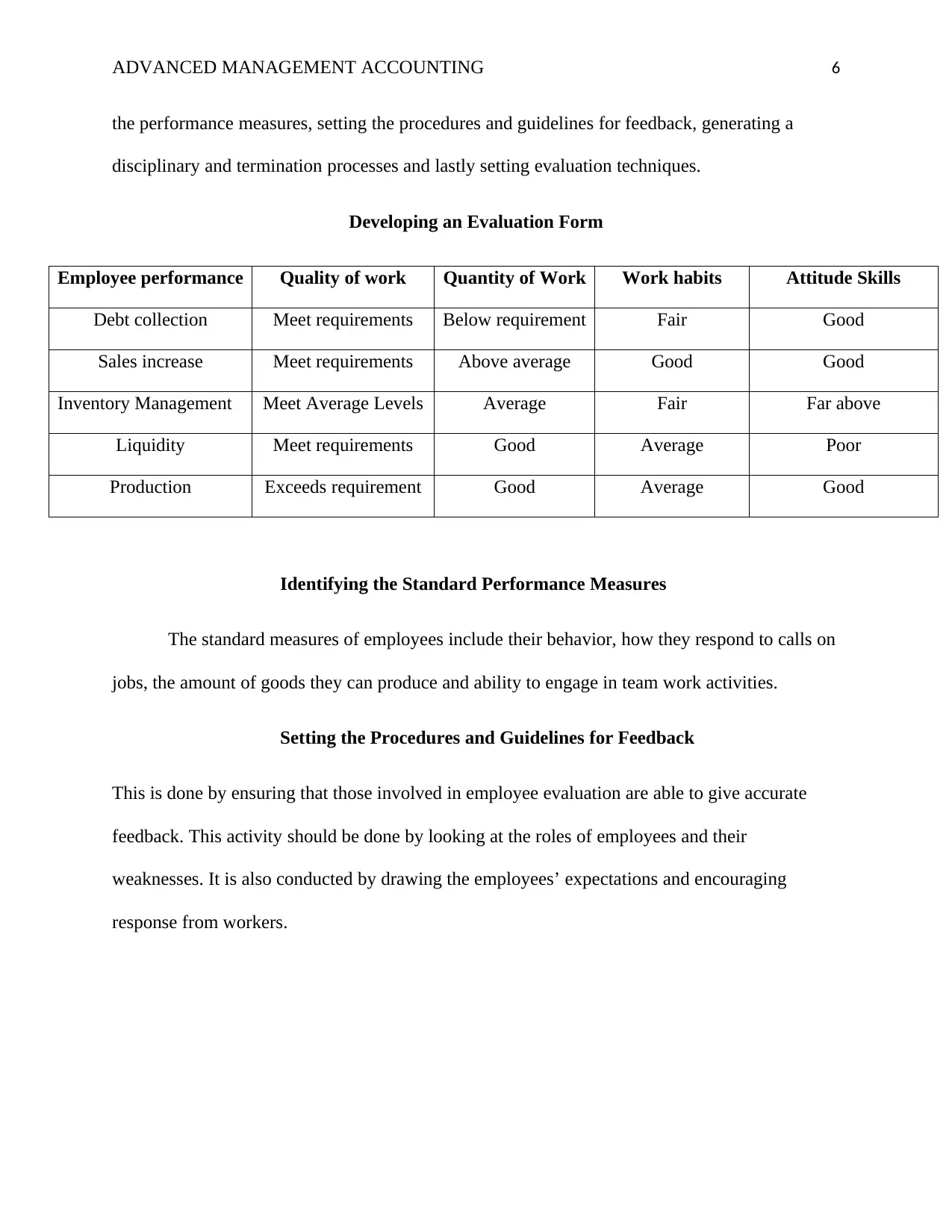
ADVANCED MANAGEMENT ACCOUNTING 6
the performance measures, setting the procedures and guidelines for feedback, generating a
disciplinary and termination processes and lastly setting evaluation techniques.
Developing an Evaluation Form
Employee performance Quality of work Quantity of Work Work habits Attitude Skills
Debt collection Meet requirements Below requirement Fair Good
Sales increase Meet requirements Above average Good Good
Inventory Management Meet Average Levels Average Fair Far above
Liquidity Meet requirements Good Average Poor
Production Exceeds requirement Good Average Good
Identifying the Standard Performance Measures
The standard measures of employees include their behavior, how they respond to calls on
jobs, the amount of goods they can produce and ability to engage in team work activities.
Setting the Procedures and Guidelines for Feedback
This is done by ensuring that those involved in employee evaluation are able to give accurate
feedback. This activity should be done by looking at the roles of employees and their
weaknesses. It is also conducted by drawing the employees’ expectations and encouraging
response from workers.
the performance measures, setting the procedures and guidelines for feedback, generating a
disciplinary and termination processes and lastly setting evaluation techniques.
Developing an Evaluation Form
Employee performance Quality of work Quantity of Work Work habits Attitude Skills
Debt collection Meet requirements Below requirement Fair Good
Sales increase Meet requirements Above average Good Good
Inventory Management Meet Average Levels Average Fair Far above
Liquidity Meet requirements Good Average Poor
Production Exceeds requirement Good Average Good
Identifying the Standard Performance Measures
The standard measures of employees include their behavior, how they respond to calls on
jobs, the amount of goods they can produce and ability to engage in team work activities.
Setting the Procedures and Guidelines for Feedback
This is done by ensuring that those involved in employee evaluation are able to give accurate
feedback. This activity should be done by looking at the roles of employees and their
weaknesses. It is also conducted by drawing the employees’ expectations and encouraging
response from workers.
⊘ This is a preview!⊘
Do you want full access?
Subscribe today to unlock all pages.

Trusted by 1+ million students worldwide
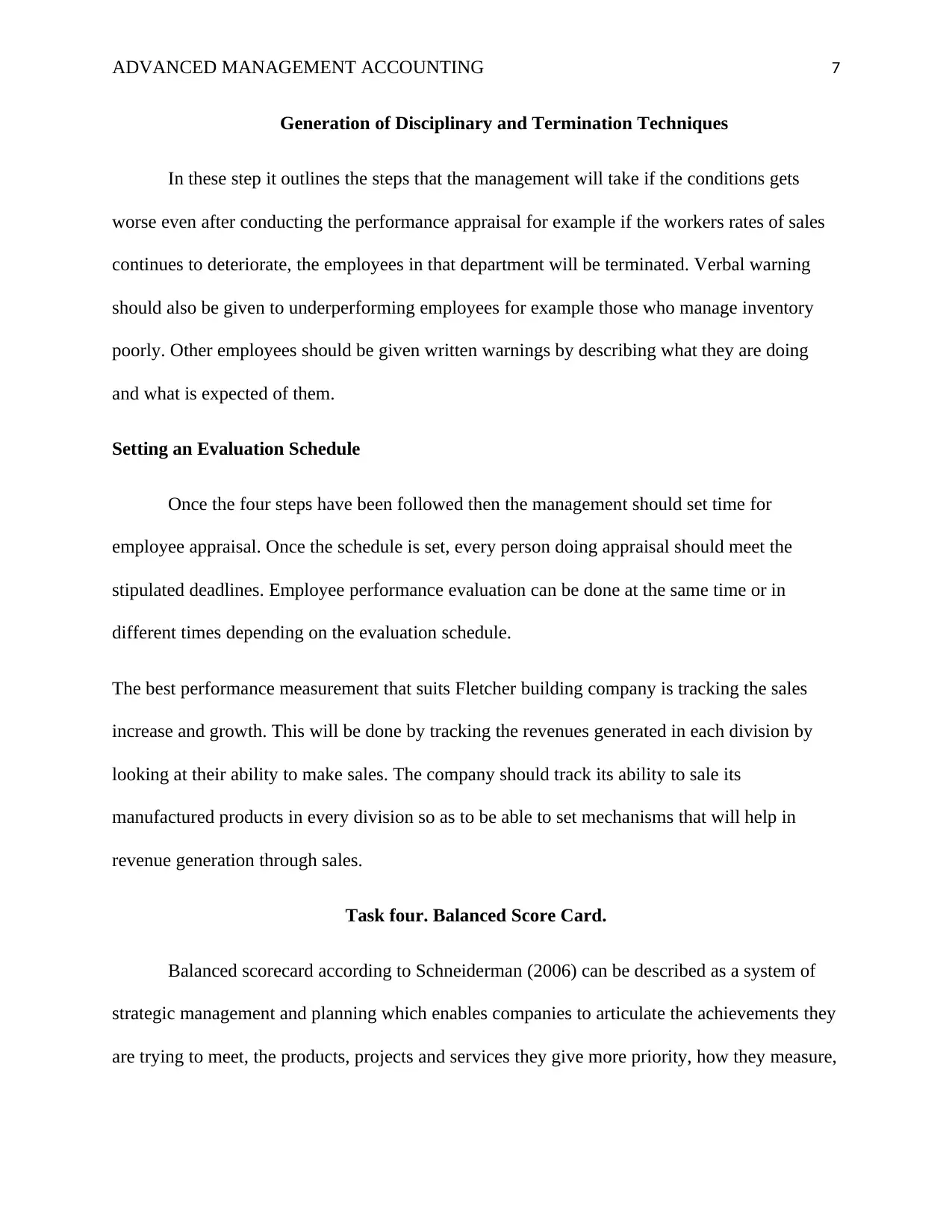
ADVANCED MANAGEMENT ACCOUNTING 7
Generation of Disciplinary and Termination Techniques
In these step it outlines the steps that the management will take if the conditions gets
worse even after conducting the performance appraisal for example if the workers rates of sales
continues to deteriorate, the employees in that department will be terminated. Verbal warning
should also be given to underperforming employees for example those who manage inventory
poorly. Other employees should be given written warnings by describing what they are doing
and what is expected of them.
Setting an Evaluation Schedule
Once the four steps have been followed then the management should set time for
employee appraisal. Once the schedule is set, every person doing appraisal should meet the
stipulated deadlines. Employee performance evaluation can be done at the same time or in
different times depending on the evaluation schedule.
The best performance measurement that suits Fletcher building company is tracking the sales
increase and growth. This will be done by tracking the revenues generated in each division by
looking at their ability to make sales. The company should track its ability to sale its
manufactured products in every division so as to be able to set mechanisms that will help in
revenue generation through sales.
Task four. Balanced Score Card.
Balanced scorecard according to Schneiderman (2006) can be described as a system of
strategic management and planning which enables companies to articulate the achievements they
are trying to meet, the products, projects and services they give more priority, how they measure,
Generation of Disciplinary and Termination Techniques
In these step it outlines the steps that the management will take if the conditions gets
worse even after conducting the performance appraisal for example if the workers rates of sales
continues to deteriorate, the employees in that department will be terminated. Verbal warning
should also be given to underperforming employees for example those who manage inventory
poorly. Other employees should be given written warnings by describing what they are doing
and what is expected of them.
Setting an Evaluation Schedule
Once the four steps have been followed then the management should set time for
employee appraisal. Once the schedule is set, every person doing appraisal should meet the
stipulated deadlines. Employee performance evaluation can be done at the same time or in
different times depending on the evaluation schedule.
The best performance measurement that suits Fletcher building company is tracking the sales
increase and growth. This will be done by tracking the revenues generated in each division by
looking at their ability to make sales. The company should track its ability to sale its
manufactured products in every division so as to be able to set mechanisms that will help in
revenue generation through sales.
Task four. Balanced Score Card.
Balanced scorecard according to Schneiderman (2006) can be described as a system of
strategic management and planning which enables companies to articulate the achievements they
are trying to meet, the products, projects and services they give more priority, how they measure,
Paraphrase This Document
Need a fresh take? Get an instant paraphrase of this document with our AI Paraphraser
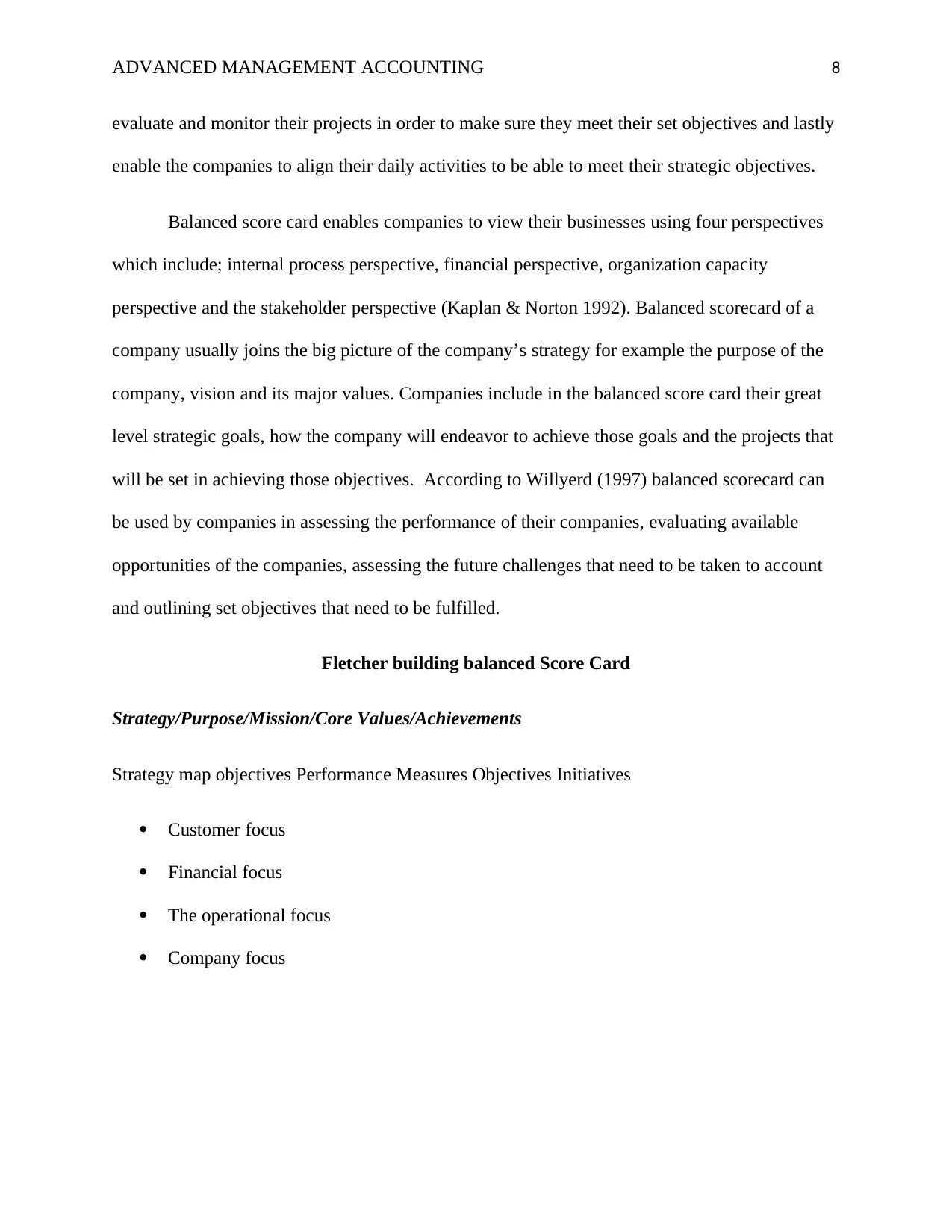
ADVANCED MANAGEMENT ACCOUNTING 8
evaluate and monitor their projects in order to make sure they meet their set objectives and lastly
enable the companies to align their daily activities to be able to meet their strategic objectives.
Balanced score card enables companies to view their businesses using four perspectives
which include; internal process perspective, financial perspective, organization capacity
perspective and the stakeholder perspective (Kaplan & Norton 1992). Balanced scorecard of a
company usually joins the big picture of the company’s strategy for example the purpose of the
company, vision and its major values. Companies include in the balanced score card their great
level strategic goals, how the company will endeavor to achieve those goals and the projects that
will be set in achieving those objectives. According to Willyerd (1997) balanced scorecard can
be used by companies in assessing the performance of their companies, evaluating available
opportunities of the companies, assessing the future challenges that need to be taken to account
and outlining set objectives that need to be fulfilled.
Fletcher building balanced Score Card
Strategy/Purpose/Mission/Core Values/Achievements
Strategy map objectives Performance Measures Objectives Initiatives
Customer focus
Financial focus
The operational focus
Company focus
evaluate and monitor their projects in order to make sure they meet their set objectives and lastly
enable the companies to align their daily activities to be able to meet their strategic objectives.
Balanced score card enables companies to view their businesses using four perspectives
which include; internal process perspective, financial perspective, organization capacity
perspective and the stakeholder perspective (Kaplan & Norton 1992). Balanced scorecard of a
company usually joins the big picture of the company’s strategy for example the purpose of the
company, vision and its major values. Companies include in the balanced score card their great
level strategic goals, how the company will endeavor to achieve those goals and the projects that
will be set in achieving those objectives. According to Willyerd (1997) balanced scorecard can
be used by companies in assessing the performance of their companies, evaluating available
opportunities of the companies, assessing the future challenges that need to be taken to account
and outlining set objectives that need to be fulfilled.
Fletcher building balanced Score Card
Strategy/Purpose/Mission/Core Values/Achievements
Strategy map objectives Performance Measures Objectives Initiatives
Customer focus
Financial focus
The operational focus
Company focus
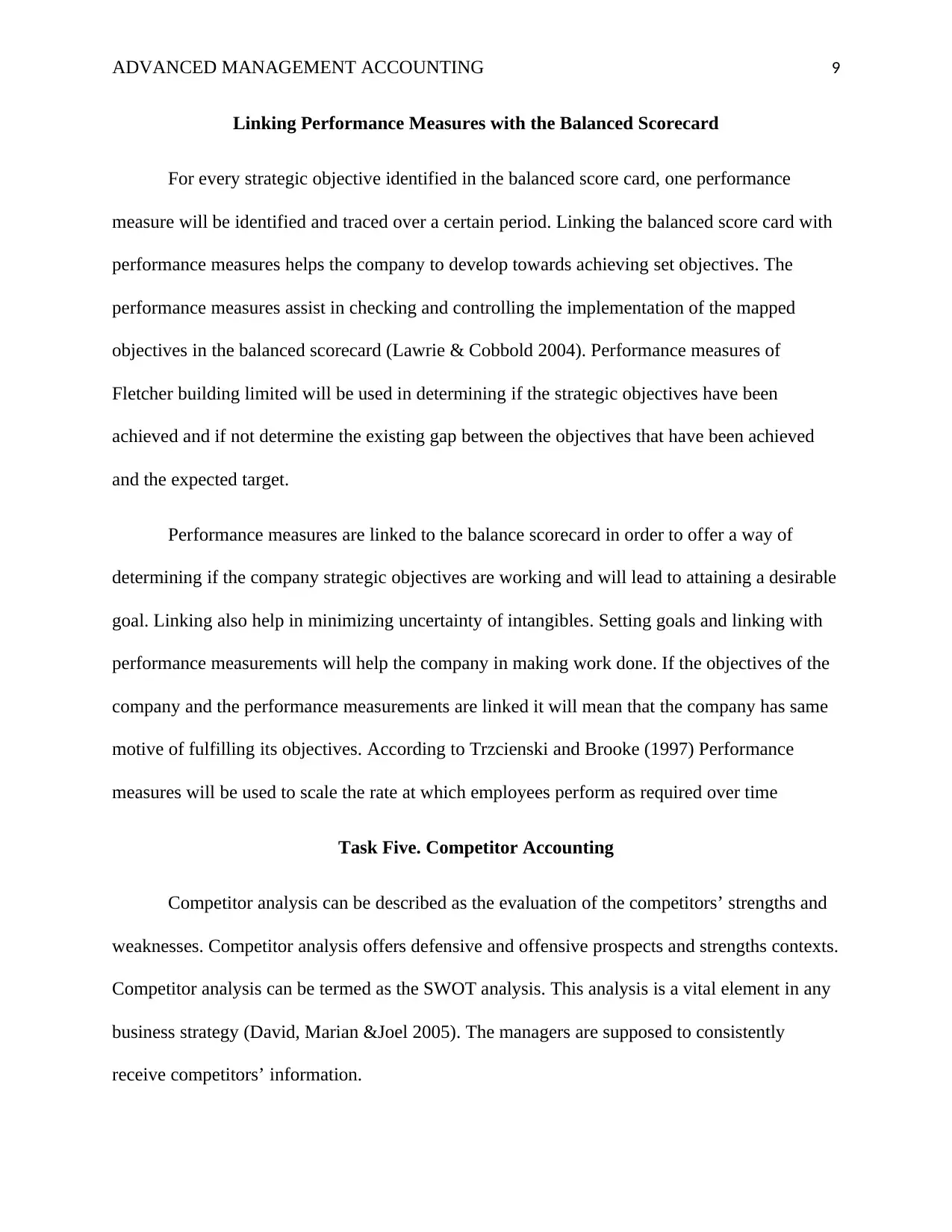
ADVANCED MANAGEMENT ACCOUNTING 9
Linking Performance Measures with the Balanced Scorecard
For every strategic objective identified in the balanced score card, one performance
measure will be identified and traced over a certain period. Linking the balanced score card with
performance measures helps the company to develop towards achieving set objectives. The
performance measures assist in checking and controlling the implementation of the mapped
objectives in the balanced scorecard (Lawrie & Cobbold 2004). Performance measures of
Fletcher building limited will be used in determining if the strategic objectives have been
achieved and if not determine the existing gap between the objectives that have been achieved
and the expected target.
Performance measures are linked to the balance scorecard in order to offer a way of
determining if the company strategic objectives are working and will lead to attaining a desirable
goal. Linking also help in minimizing uncertainty of intangibles. Setting goals and linking with
performance measurements will help the company in making work done. If the objectives of the
company and the performance measurements are linked it will mean that the company has same
motive of fulfilling its objectives. According to Trzcienski and Brooke (1997) Performance
measures will be used to scale the rate at which employees perform as required over time
Task Five. Competitor Accounting
Competitor analysis can be described as the evaluation of the competitors’ strengths and
weaknesses. Competitor analysis offers defensive and offensive prospects and strengths contexts.
Competitor analysis can be termed as the SWOT analysis. This analysis is a vital element in any
business strategy (David, Marian &Joel 2005). The managers are supposed to consistently
receive competitors’ information.
Linking Performance Measures with the Balanced Scorecard
For every strategic objective identified in the balanced score card, one performance
measure will be identified and traced over a certain period. Linking the balanced score card with
performance measures helps the company to develop towards achieving set objectives. The
performance measures assist in checking and controlling the implementation of the mapped
objectives in the balanced scorecard (Lawrie & Cobbold 2004). Performance measures of
Fletcher building limited will be used in determining if the strategic objectives have been
achieved and if not determine the existing gap between the objectives that have been achieved
and the expected target.
Performance measures are linked to the balance scorecard in order to offer a way of
determining if the company strategic objectives are working and will lead to attaining a desirable
goal. Linking also help in minimizing uncertainty of intangibles. Setting goals and linking with
performance measurements will help the company in making work done. If the objectives of the
company and the performance measurements are linked it will mean that the company has same
motive of fulfilling its objectives. According to Trzcienski and Brooke (1997) Performance
measures will be used to scale the rate at which employees perform as required over time
Task Five. Competitor Accounting
Competitor analysis can be described as the evaluation of the competitors’ strengths and
weaknesses. Competitor analysis offers defensive and offensive prospects and strengths contexts.
Competitor analysis can be termed as the SWOT analysis. This analysis is a vital element in any
business strategy (David, Marian &Joel 2005). The managers are supposed to consistently
receive competitors’ information.
⊘ This is a preview!⊘
Do you want full access?
Subscribe today to unlock all pages.

Trusted by 1+ million students worldwide
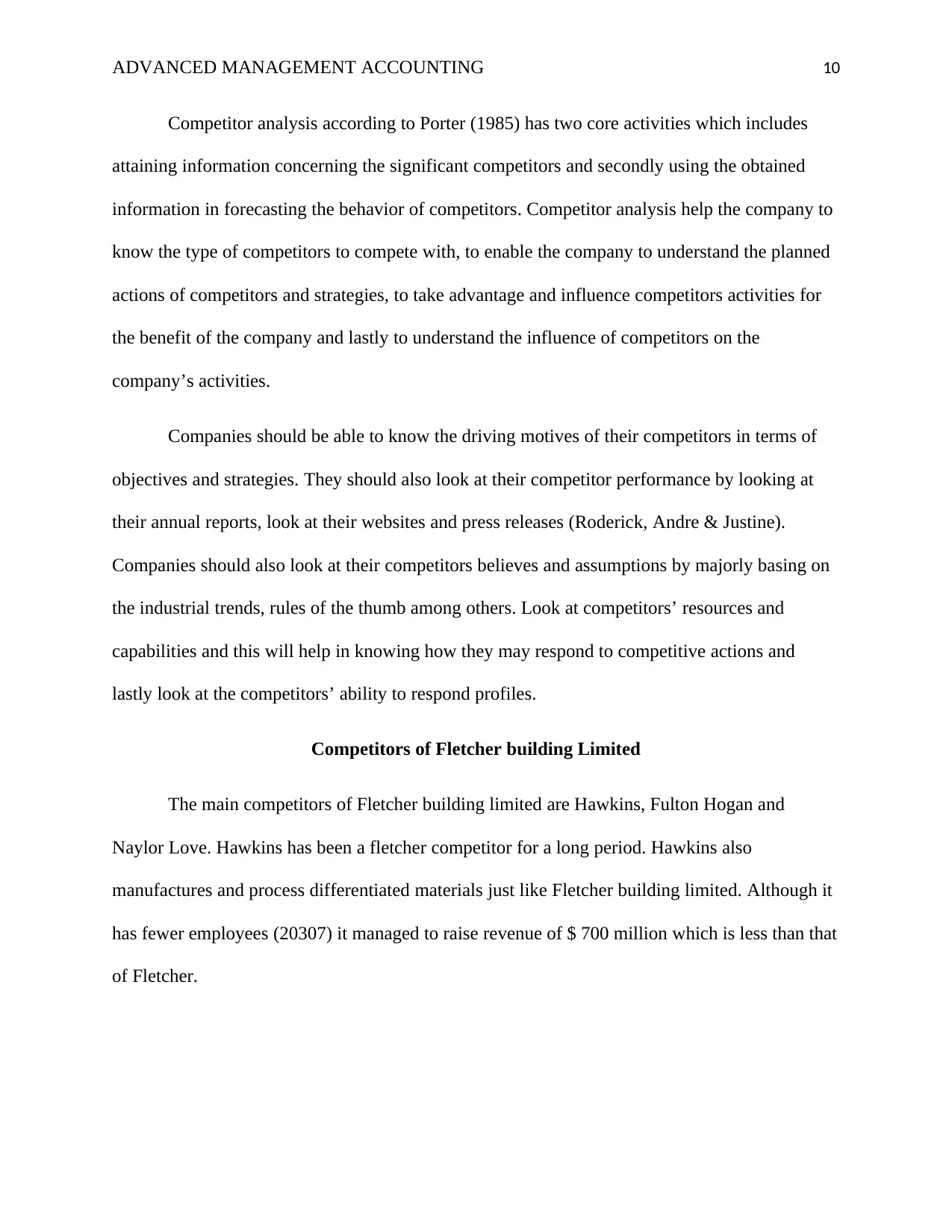
ADVANCED MANAGEMENT ACCOUNTING 10
Competitor analysis according to Porter (1985) has two core activities which includes
attaining information concerning the significant competitors and secondly using the obtained
information in forecasting the behavior of competitors. Competitor analysis help the company to
know the type of competitors to compete with, to enable the company to understand the planned
actions of competitors and strategies, to take advantage and influence competitors activities for
the benefit of the company and lastly to understand the influence of competitors on the
company’s activities.
Companies should be able to know the driving motives of their competitors in terms of
objectives and strategies. They should also look at their competitor performance by looking at
their annual reports, look at their websites and press releases (Roderick, Andre & Justine).
Companies should also look at their competitors believes and assumptions by majorly basing on
the industrial trends, rules of the thumb among others. Look at competitors’ resources and
capabilities and this will help in knowing how they may respond to competitive actions and
lastly look at the competitors’ ability to respond profiles.
Competitors of Fletcher building Limited
The main competitors of Fletcher building limited are Hawkins, Fulton Hogan and
Naylor Love. Hawkins has been a fletcher competitor for a long period. Hawkins also
manufactures and process differentiated materials just like Fletcher building limited. Although it
has fewer employees (20307) it managed to raise revenue of $ 700 million which is less than that
of Fletcher.
Competitor analysis according to Porter (1985) has two core activities which includes
attaining information concerning the significant competitors and secondly using the obtained
information in forecasting the behavior of competitors. Competitor analysis help the company to
know the type of competitors to compete with, to enable the company to understand the planned
actions of competitors and strategies, to take advantage and influence competitors activities for
the benefit of the company and lastly to understand the influence of competitors on the
company’s activities.
Companies should be able to know the driving motives of their competitors in terms of
objectives and strategies. They should also look at their competitor performance by looking at
their annual reports, look at their websites and press releases (Roderick, Andre & Justine).
Companies should also look at their competitors believes and assumptions by majorly basing on
the industrial trends, rules of the thumb among others. Look at competitors’ resources and
capabilities and this will help in knowing how they may respond to competitive actions and
lastly look at the competitors’ ability to respond profiles.
Competitors of Fletcher building Limited
The main competitors of Fletcher building limited are Hawkins, Fulton Hogan and
Naylor Love. Hawkins has been a fletcher competitor for a long period. Hawkins also
manufactures and process differentiated materials just like Fletcher building limited. Although it
has fewer employees (20307) it managed to raise revenue of $ 700 million which is less than that
of Fletcher.
Paraphrase This Document
Need a fresh take? Get an instant paraphrase of this document with our AI Paraphraser
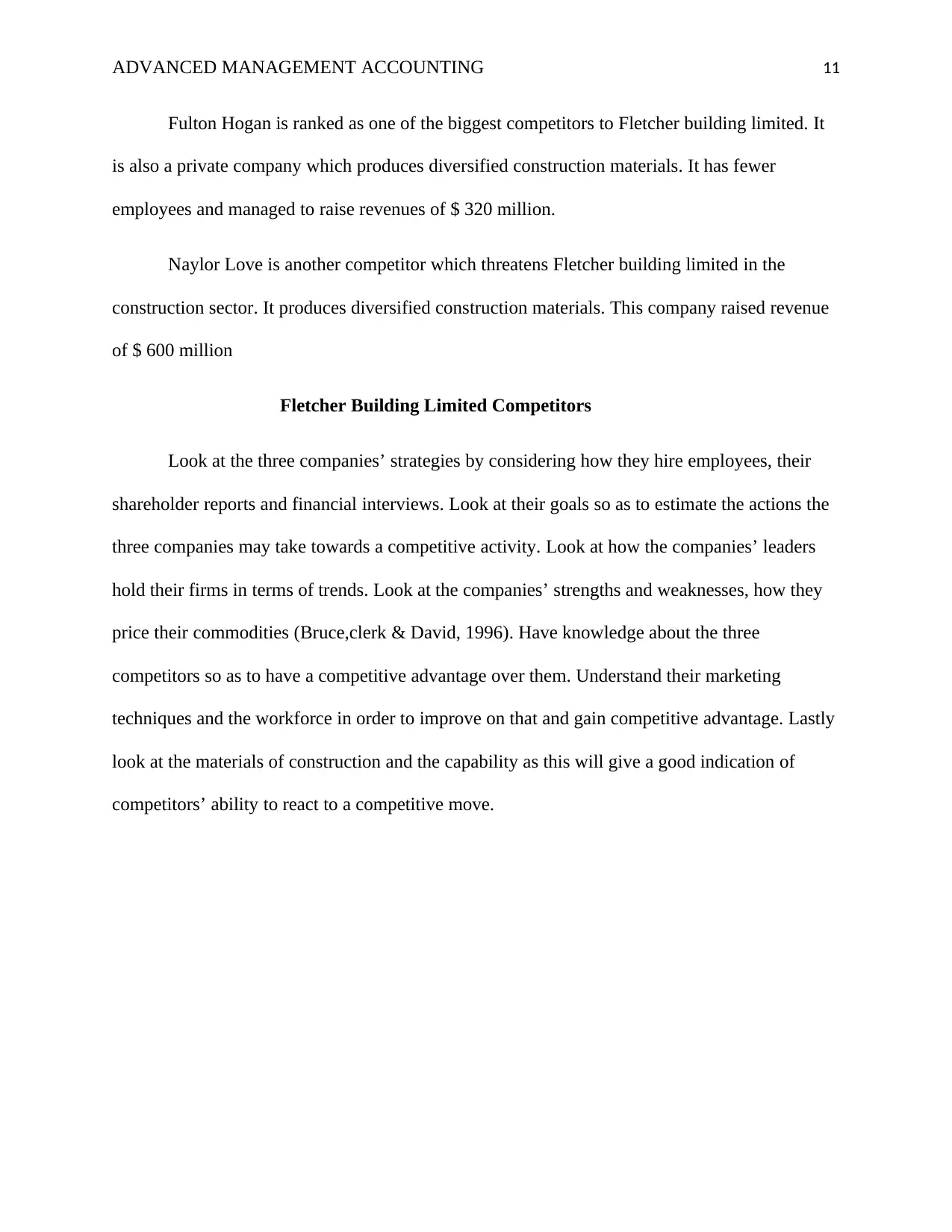
ADVANCED MANAGEMENT ACCOUNTING 11
Fulton Hogan is ranked as one of the biggest competitors to Fletcher building limited. It
is also a private company which produces diversified construction materials. It has fewer
employees and managed to raise revenues of $ 320 million.
Naylor Love is another competitor which threatens Fletcher building limited in the
construction sector. It produces diversified construction materials. This company raised revenue
of $ 600 million
Fletcher Building Limited Competitors
Look at the three companies’ strategies by considering how they hire employees, their
shareholder reports and financial interviews. Look at their goals so as to estimate the actions the
three companies may take towards a competitive activity. Look at how the companies’ leaders
hold their firms in terms of trends. Look at the companies’ strengths and weaknesses, how they
price their commodities (Bruce,clerk & David, 1996). Have knowledge about the three
competitors so as to have a competitive advantage over them. Understand their marketing
techniques and the workforce in order to improve on that and gain competitive advantage. Lastly
look at the materials of construction and the capability as this will give a good indication of
competitors’ ability to react to a competitive move.
Fulton Hogan is ranked as one of the biggest competitors to Fletcher building limited. It
is also a private company which produces diversified construction materials. It has fewer
employees and managed to raise revenues of $ 320 million.
Naylor Love is another competitor which threatens Fletcher building limited in the
construction sector. It produces diversified construction materials. This company raised revenue
of $ 600 million
Fletcher Building Limited Competitors
Look at the three companies’ strategies by considering how they hire employees, their
shareholder reports and financial interviews. Look at their goals so as to estimate the actions the
three companies may take towards a competitive activity. Look at how the companies’ leaders
hold their firms in terms of trends. Look at the companies’ strengths and weaknesses, how they
price their commodities (Bruce,clerk & David, 1996). Have knowledge about the three
competitors so as to have a competitive advantage over them. Understand their marketing
techniques and the workforce in order to improve on that and gain competitive advantage. Lastly
look at the materials of construction and the capability as this will give a good indication of
competitors’ ability to react to a competitive move.
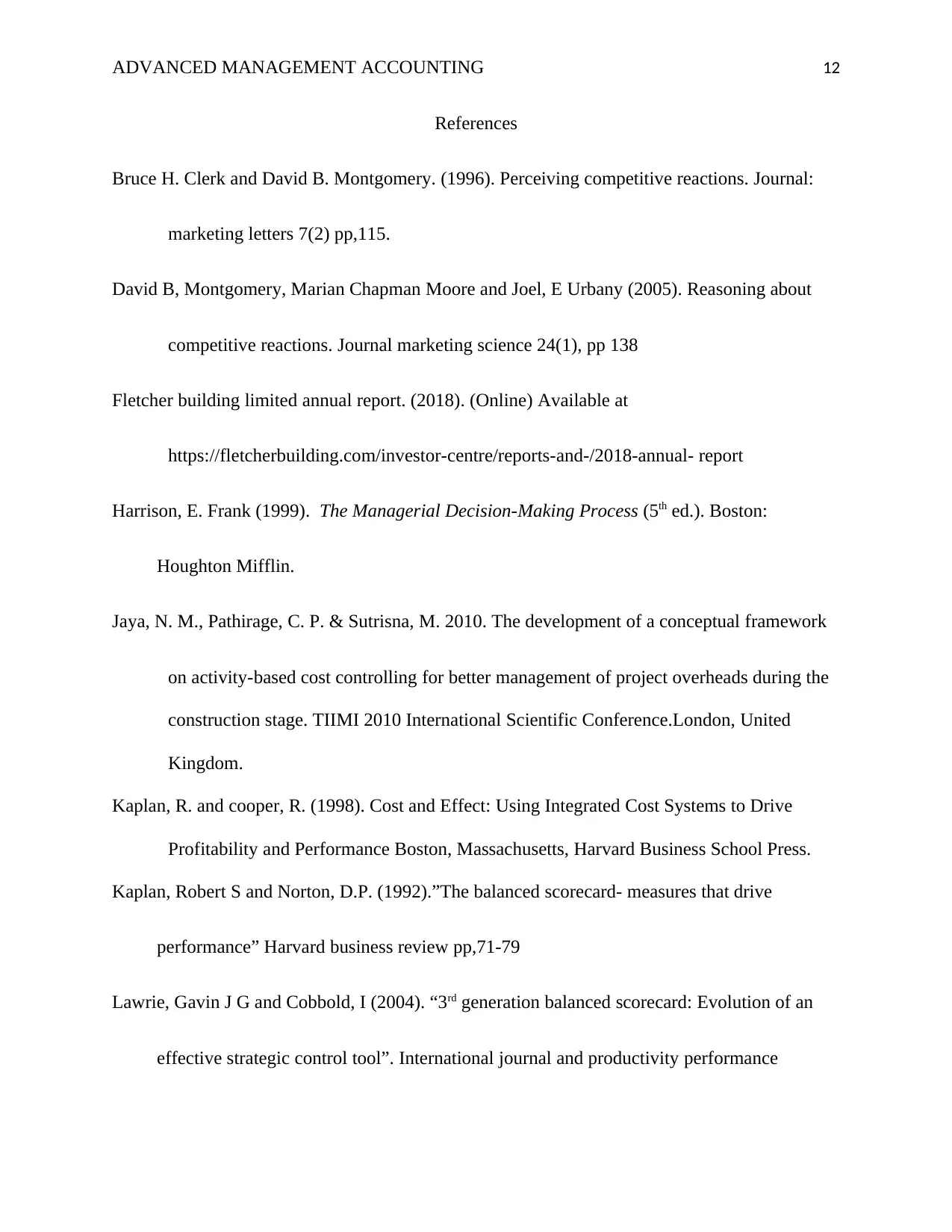
ADVANCED MANAGEMENT ACCOUNTING 12
References
Bruce H. Clerk and David B. Montgomery. (1996). Perceiving competitive reactions. Journal:
marketing letters 7(2) pp,115.
David B, Montgomery, Marian Chapman Moore and Joel, E Urbany (2005). Reasoning about
competitive reactions. Journal marketing science 24(1), pp 138
Fletcher building limited annual report. (2018). (Online) Available at
https://fletcherbuilding.com/investor-centre/reports-and-/2018-annual- report
Harrison, E. Frank (1999). The Managerial Decision-Making Process (5th ed.). Boston:
Houghton Mifflin.
Jaya, N. M., Pathirage, C. P. & Sutrisna, M. 2010. The development of a conceptual framework
on activity-based cost controlling for better management of project overheads during the
construction stage. TIIMI 2010 International Scientific Conference.London, United
Kingdom.
Kaplan, R. and cooper, R. (1998). Cost and Effect: Using Integrated Cost Systems to Drive
Profitability and Performance Boston, Massachusetts, Harvard Business School Press.
Kaplan, Robert S and Norton, D.P. (1992).”The balanced scorecard- measures that drive
performance” Harvard business review pp,71-79
Lawrie, Gavin J G and Cobbold, I (2004). “3rd generation balanced scorecard: Evolution of an
effective strategic control tool”. International journal and productivity performance
References
Bruce H. Clerk and David B. Montgomery. (1996). Perceiving competitive reactions. Journal:
marketing letters 7(2) pp,115.
David B, Montgomery, Marian Chapman Moore and Joel, E Urbany (2005). Reasoning about
competitive reactions. Journal marketing science 24(1), pp 138
Fletcher building limited annual report. (2018). (Online) Available at
https://fletcherbuilding.com/investor-centre/reports-and-/2018-annual- report
Harrison, E. Frank (1999). The Managerial Decision-Making Process (5th ed.). Boston:
Houghton Mifflin.
Jaya, N. M., Pathirage, C. P. & Sutrisna, M. 2010. The development of a conceptual framework
on activity-based cost controlling for better management of project overheads during the
construction stage. TIIMI 2010 International Scientific Conference.London, United
Kingdom.
Kaplan, R. and cooper, R. (1998). Cost and Effect: Using Integrated Cost Systems to Drive
Profitability and Performance Boston, Massachusetts, Harvard Business School Press.
Kaplan, Robert S and Norton, D.P. (1992).”The balanced scorecard- measures that drive
performance” Harvard business review pp,71-79
Lawrie, Gavin J G and Cobbold, I (2004). “3rd generation balanced scorecard: Evolution of an
effective strategic control tool”. International journal and productivity performance
⊘ This is a preview!⊘
Do you want full access?
Subscribe today to unlock all pages.

Trusted by 1+ million students worldwide
1 out of 13
Related Documents
Your All-in-One AI-Powered Toolkit for Academic Success.
+13062052269
info@desklib.com
Available 24*7 on WhatsApp / Email
![[object Object]](/_next/static/media/star-bottom.7253800d.svg)
Unlock your academic potential
Copyright © 2020–2025 A2Z Services. All Rights Reserved. Developed and managed by ZUCOL.




